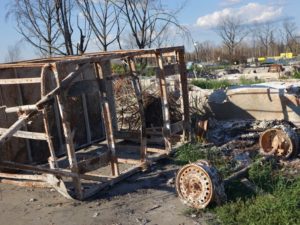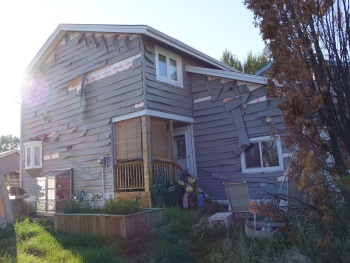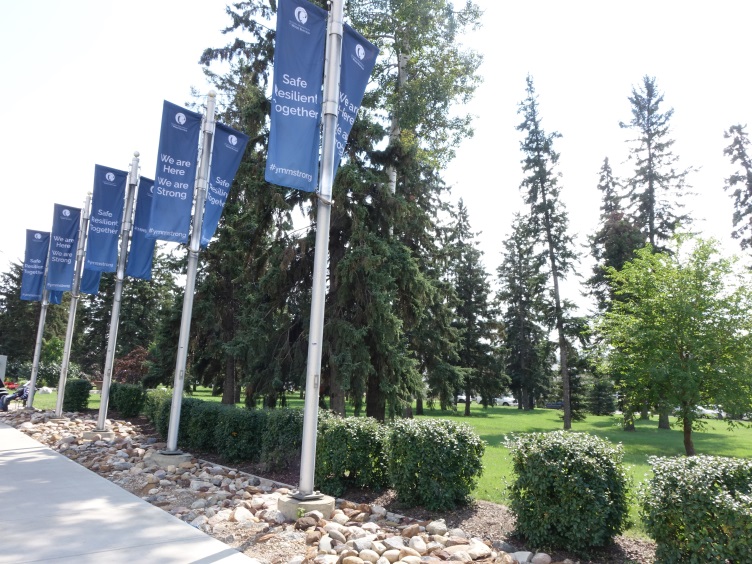The fire came up from the south. But if you live in that part of Canada, in northern Alberta, you’ve encountered forest fires before.
Brenda Brewer, clerk of session at Faith, the Presbyterian church in Fort McMurray, and her husband Irvine, went to visit one of their three daughters in Carstairs over the weekend. They returned on Monday, May 2. The next day they went to the golf course, down the hill from their home. It was there they decided they’d better evacuate.
Their cars weren’t gassed up. Brenda went to one daughter living in town; Irv to another. Brenda left that afternoon, two toddler grandkids in the back, a wall of fire to their left. The youngest was crying. Brenda took over the wheel as her daughter sat with the kids. The driving was slow; the roads were packed. Tens of thousands of people were trying to get out. Her husband Irv stayed overnight with another daughter and her family. They evacuated the next morning. They didn’t see any fires.
Fort McMurray, Alta., is a sprawling city at the confluence of five rivers—Athabasca, Clearwater, Horse, Hangingstone and Christina. It was here the Hudson’s Bay Company built a trading post in 1870 to deliver goods to the Artic. The old city is in the valley, but the newer subdivisions—more than half the town is less than 20 years old—is on the plateaus between the rivers. Depending on where you lived, you were either in the fire zone, or not at all.
Nobody thought the city would catch because the rivers form a natural fire barrier. Certainly not Byron Bailey, an elder at Faith. He left his three-storey, split level home in the older subdivision of Abasand to meet a client at Starbucks. His house was up on a hill, in the nook between the very wide Athabasca and Clearwater rivers. He watched his house burn from the coffee shop on Tuesday, May 3. All he had was what he brought for his business meeting.
His was one of about 2,000 homes reduced to a pile of fine white ash. The fire also ate another 400 non-residential buildings. There was plenty of heat, fuel and oxidizing agents—a trifecta to feed a blaze. “We don’t think of all the things which are fire starters in our homes—propane cans, pressurized cans,” Byron Bailey explains, surveying the square of ash that was once his home. “See,” he says pointing to a metal carcass, “I had a barbeque. Like everyone else. That must have been another explosion inside the fire. One friend told me about all the explosions he heard. That was all household stuff.”
The fire devoured a few buildings on the Brewers’ favourite golf course, which sits in the bend of the Athabasca River. Plus some golf carts. It was a perfect combination of a dry spring, a strong wind and a determined fire.
It was from the golf course the Brewers could see the fire approaching their home on Woodward Lane. The fire came close. “It was like a port city at night but it wasn’t fog, it was smoke. I don’t have any respiratory issues but I had difficulty. It was pungent,” says Irv Brewer. He grabbed their box of important documents, his laptop and a backup hard drive. He monitored his house through the air conditioning app on his phone. “If it stopped giving me readings, I’d know something had happened.” Nothing did happen, though the outside temperature was extreme for a couple of days. He tried to keep the house as cool as possible via remote.
Across the street from the Brewers’ home is a park and beyond that, beautifully landscaped trails through the woods, with wooden benches and occasional vistas over the golf course and the Athabasca River. The fire licked through the woods, at one point within a dozen metres of a home.
 That wasn’t just luck; it was the strategic hard work of many different fire crews working together. “The city fire men didn’t know how to deal with a raging forest fire. And the forest fire crews didn’t know how to deal with an urban setting,” explains Bailey. “They had to work together.” And they did, making impossible decisions like forsaking Bailey’s district of Abasand and saving others.
That wasn’t just luck; it was the strategic hard work of many different fire crews working together. “The city fire men didn’t know how to deal with a raging forest fire. And the forest fire crews didn’t know how to deal with an urban setting,” explains Bailey. “They had to work together.” And they did, making impossible decisions like forsaking Bailey’s district of Abasand and saving others.
Swaths of land were bulldozed and soaked in fire retardant to keep the flames away from homes. The heat was intense at times—the siding melted on some homes. The power went out in other areas, though the houses were untouched by the fire. Still, upon return all the houses on some streets had to replace their fridges and freezers. As of early August, three months from when the fires hit town, some houses still sit empty.
Residents have been allowed to visit their homes—or, in many cases, visit the site that was their home. Bailey tells of a neighbour who found her wedding ring in the mound of ash that was her house. Another friend returned to find her pets alive and well. She had fretted about them for ages, full of guilt and fear.
Miracles within a traumatic conflagration. Rev. Joan Heffelfinger, a retired United Church minister and a member at Faith, has a physical condition that keeps her in constant pain. On May 3 she evacuated with her son. The drive was slow and tiring. They arrived at an evacuation camp to find it full; they moved to another. After hours in the car, she thought to stretch her legs and relieve some of the discomfort. Stepping out, her legs buckled and she fell, luckily caught by her son at the last moment.
The second camp was also full and she was feeling despondent when a man, who had obviously been drinking, came to her and handed her a set of keys. “I got a room in this camp. I think you need this more than me,” he said. He kept in touch with her during the evacuation period. A moment of grace, she recalls.

THE EXPLORER ALEXANDER MACKENZIE made a reference to the pitch flowing into the rivers in 1788. Later explorers, including David Thompson in 1799, also noted that the natives used the pitch to line their canoes. That pitch—bitumen—would dominate the Fort McMurray story in the 20th century.
Fort McMurray is today, and has been for half a century, a two company town—Suncor and Syncrude—though there were previous attempts to pull the oil out of the sands. Suncor arrived first in the 1960s, with an initial $250 million, then the largest private investment in Canada. It was deemed a huge risk. The first oil flowed in 1968, a billion dollars later. Syncrude arrived in the 1970s and started pumping in 1978.
Together the two companies built the town—they were the housing developers as well at the start. There were just under 39,000 people on the 2001 census. About 90,000 were evacuated this May. The boom, responding to international economies, has been intense. Workers have moved there from across Canada and the world. About two per cent of the population speaks Tagalog, for example. You can have injera or jerk at local restaurants. The Muslim population is 10,000-strong and is building a mega-mosque on 9.5 acres. The median family income in the municipal district is almost $200,000; more than double Canada’s average of $70,000. It is a young, wealthy, diverse and active community. And the two foundational companies are the benefactors. The cheques didn’t stop during the evacuation period; certainly not for senior management who worked via remote, and also not for the labourers stretched across the country waiting to return.
Oil is essential to the Alberta economy. In 2013, nearly a quarter of the province’s $332-billion economy was in the energy sector. About a tenth of all Alberta jobs are in the oil business.
And the oil business is a rollercoaster. The highs are high and the lows are low. The oil business has been low in the past year. Fort McMurray was already feeling the pressure of crashing prices before the fire.
And, of course, the oil sands, outside of Alberta, are controversial. A recent report from the Pembina Institute shows that carbon emissions from the oil sands have increased 25 per cent from 2004 to 2014. There are other reports refuting this report; and counter-reports. In the rhetoric of our times the world’s second largest oil reserve is either the most devastating environmental blight on Canada, or the most important economic source. Health and other impacts are debated vociferously, if not intelligently.
Needless to say Fort McMurray folk are defensive. They feel attacked. They are loyal to the industry that nourishes them, and the companies that not only employ them but also build community institutions for them. There’s an unspoken code to not talk about the criticism from environmentalists. Albertans are pragmatic people; conservative in many ways. Perhaps it is the other industry which dominates the province that defines their character: Like farmers, they continue, through good years and bad, riding circumstances. They continue. Banners declaring Fort McMurray pride and resolve to rebuild hang all over town, and on bumper stickers.

FAITH IS CURRENTLY SEEKING a minister. It’s one more thing that hangs over them, along with a struggling oil economy and the aftermath of the fire.
On July 24, Byron Bailey led the worship and delivered the meditation. He picked a variety of different Bible passages, beginning with the Beatitudes. “Our economy isn’t perfect,” he said to the congregation from the pulpit. “Our weather isn’t perfect. It wasn’t perfect early this May. Because it is not a perfect world; life is full of losses. This is not heaven. Nothing works perfectly all the time so we have trials and tribulations. And I tell you it’s been a trial. … So today’s question is, how do you rise above the inevitable losses in life? How do we deal with the tribulations created by the fire?
“You aren’t taking your car to heaven. You aren’t taking your home to heaven. You aren’t taking your clothes to heaven. But, you are taking your character to heaven. God is more interested in your character and its development than your comfort. These troubles are getting us ready for an eternal glory and this is a comfort. This is the warm up stage, this is preschool stage, this is the learning stage. God is getting us ready for an eternal glory and that is a comfort. You need to see the meaning and purpose in your pain and grief.
“You may have been burned out by the fire but you have a choice of whether it is going to make you bitter or better. A stepping stone or a stumbling block. God works good for those that love Him. He prepares us for eternity.”

